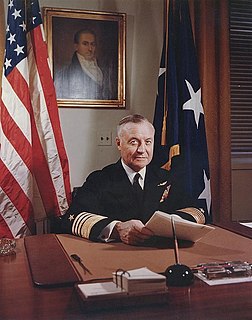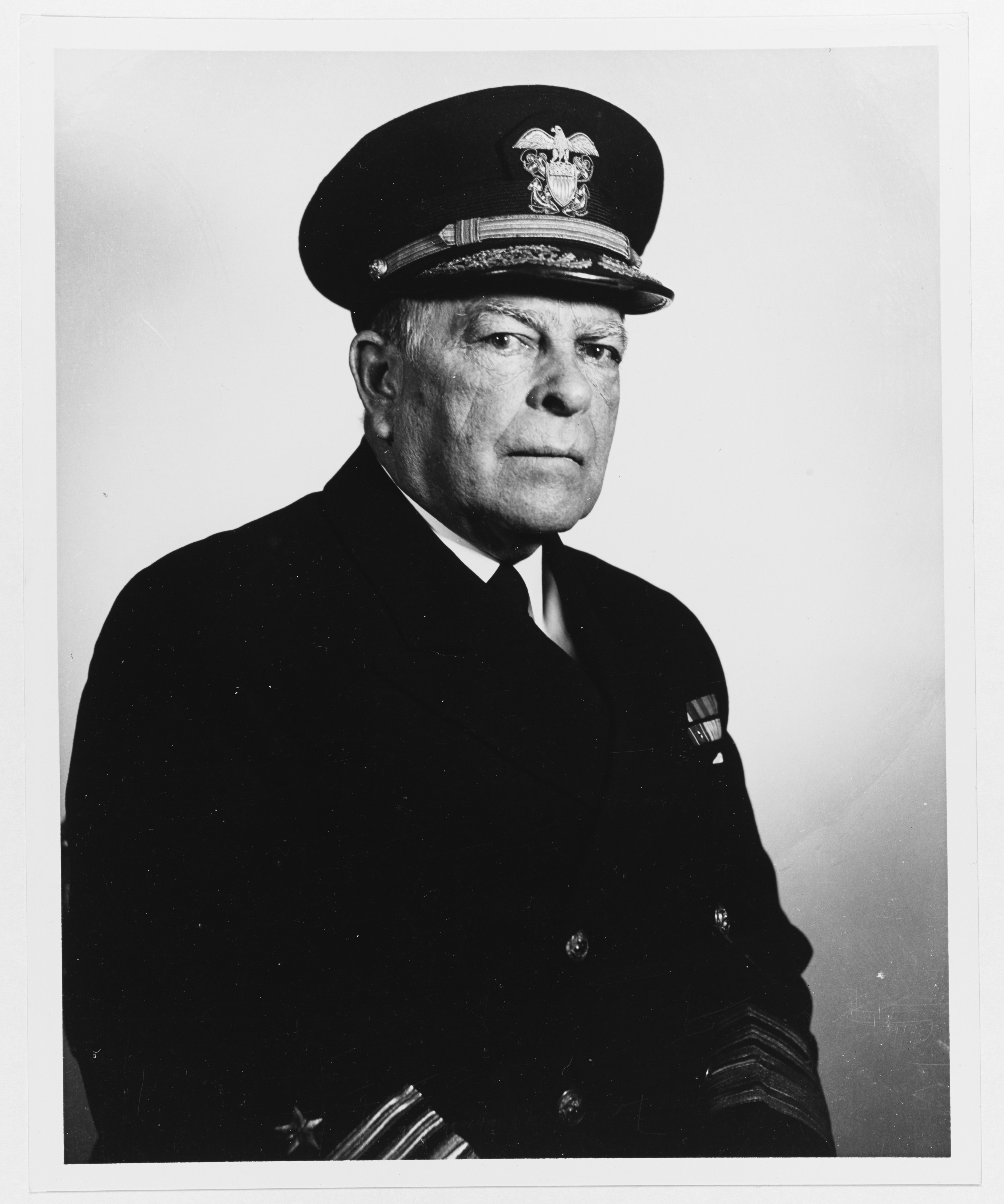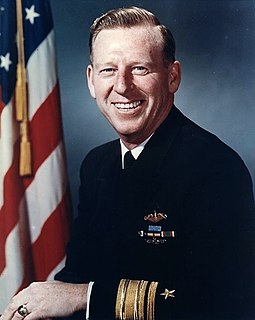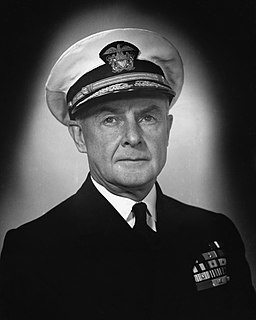Related Research Articles

The United States Pacific Fleet (USPACFLT) is a theater-level component command of the United States Navy, located in the Pacific Ocean. It provides naval forces to the Indo-Pacific Command. Fleet headquarters is at Naval Station Pearl Harbor, Hawaii, with large secondary facilities at North Island, San Diego Bay on the Mainland.

Jesse Barrett "Oley" Oldendorf was an admiral in the United States Navy, famous for defeating a Japanese force in the Battle of Leyte Gulf during World War II. He also served as commander of the American naval forces during the early phase of the Battle of the Caribbean. In early 1942, a secret group of senior Navy officers empaneled by President Franklin D. Roosevelt assessed him as one of the 40 most competent of the 120 flag officers in the Navy.

Forrest Percival Sherman was an admiral in the United States Navy and the youngest person to serve as Chief of Naval Operations until Admiral Elmo Zumwalt in 1970. The Forrest Sherman-class destroyer was named for him.

Lieutenant Admiral Conrad Emil Lambert Helfrich of the Royal Netherlands Navy was a leading Dutch naval figure of World War II. He was born in Semarang.

Vice Admiral William Satterlee Pye, United States Navy, was a U.S. Navy officer who served during World War I and World War II, but never saw combat action. His last active-duty appointment was as President of the Naval War College, in 1942–1946. His awards included the Navy Cross for his distinguished service as a staff officer during World War I.

Thomas Charles Hart was an admiral in the United States Navy, whose service extended from the Spanish–American War through World War II. Following his retirement from the navy, he served briefly as a United States Senator from Connecticut.

Eugene Bennett Fluckey, nicknamed "Lucky Fluckey", was a United States Navy rear admiral who received the Medal of Honor and four Navy Crosses during his service as a submarine commander in World War II.

Glynn Robert Donaho, nicknamed "Donc", was a U.S. Navy officer known principally for his exploits as a submarine commander during World War II, for which he received the Navy Cross four times, the Silver Star twice, and the Bronze Star.

Cassin Young was a captain in the United States Navy who received the Medal of Honor for his heroism during the attack on Pearl Harbor.

Theodore Gordon Ellyson, USN, nicknamed "Spuds", was the first United States Navy officer designated as an aviator. Ellyson served in the experimental development of aviation in the years before and after World War I. He also spent several years before the war as part of the Navy's new submarine service. A recipient of the Navy Cross for his antisubmarine service in World War I, Ellyson died in 1928 when his aircraft crashed over the Chesapeake Bay.

Lawson Paterson "Red" Ramage was a vice admiral in the United States Navy and a noted submarine commander during World War II. Ramage was decorated with the Medal of Honor and several other combat decorations during the war. He also served during the Korean War and the Vietnam War.

Rear Admiral Frederick Lois Riefkohl, a native of Maunabo, Puerto Rico, was an officer in the United States Navy and the first Puerto Rican to graduate from the United States Naval Academy and to be awarded the Navy Cross. The Navy Cross is the second highest medal, after the Medal of Honor, that can be awarded by the U.S. Navy for heroism or distinguished service. He was a World War I Navy Cross recipient who served as Captain of the USS Vincennes during World War II.

Roy Stanley Benson, nicknamed "Ensign", was a veteran submarine commander in World War II who later served as the Commander Submarine Force U.S. Pacific Fleet (COMSUBPAC) during the Cold War.

Vice Admiral Allan Rockwell McCann, was a United States Navy officer who served in World War I and World War II.

Ignatius Joseph "Pete" Galantin was a four-star United States Navy admiral, World War II Navy Cross recipient, and the first commander of the Naval Material Command.

Admiral Charles Maynard "Savvy" Cooke Jr., USN, was a United States Navy four star admiral who saw service in World War I and World War II and later served as commander of United States Seventh Fleet (COMSEVENTHFLT) from 1946 to 1947 and commander of U.S. Naval Forces, Western Pacific (COMNAVWESPAC) from 1947 to 1948.

Bernard Lige Austin was a Vice Admiral of the United States Navy. His career included service in World War II, the Korean War, and the Cold War and command of submarines and surface ship forces, during which he became a distinguished combat commander of destroyers. He also commanded the United States Second Fleet, held numerous diplomatic, educational, and administrative staff positions, and a served a lengthy tour of duty as President of the Naval War College.

Vice Admiral Frank Jacob Lowry was an officer in the United States Navy who served in World War I and World War II. A 1911 graduate of the United States Naval Academy, he served on submarines during World War I. During World War II, he commanded the cruiser USS Minneapolis at the Battle of the Coral Sea, for which he was awarded the Navy Cross, and the Battle of Midway. He commanded the VIII Amphibious Force in the landings at Anzio and Southern France. He retired from the Navy in March 1950, and received a tombstone promotion to vice admiral due to his combat decorations.

Rear Admiral William Reynolds Purnell was an officer in the United States Navy who served in World War I and World War II. A 1908 graduate of the United States Naval Academy, he captained destroyers during World War I. He was awarded the Navy Cross for his role in protecting convoys against German submarines as commander of the USS Lamson.

Alan Boyd Banister was a decorated submarine commander during World War II who reached the rank of Rear Admiral in the United States Navy.
References
- 1 2 "Picking (DD-685)". Naval History and Heritage Command.
- ↑ "The Navy Cross to Members of the US Navy: World War 1". www.homeofheroes.com.
- ↑ "Sherwood Picking". The Hall of Valor Project.
- 1 2 "Ship's Namesake: Capt. Sherwood Picking, USN". www.uss-picking.org.